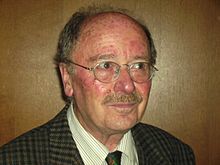Street of Peace (art project)
The Street of Peace is an artistic project that the German painter and sculptor Otto Freundlich (* 1887, † 1943) developed.
History of origin
In the 1920s, the German-Jewish humanist and pacifist Otto Freundlich developed the idea of a "Street of Sculptures Paris-Moscow" (French original name: "Une voie de la fraternité et solidarité humaine"). He saw it as a way of brotherhood and human solidarity, it should be a visible sign of the turning away from war and human violence and of the peaceful coexistence of different nations. After years of exile in France and as a result of his murder by the Nazis in the Lublin-Majdanek concentration camp, Freundlich was no longer able to turn his idea into reality.
The St. Wendel artist Leo Kornbrust took up Freundlich's vision in 1971 and staged a street of sculptures in St. Wendler Land , which he understood as a homage to the artist he admired and as the first section of a "street of peace". Kornbrust wanted to further develop this Friedensstrasse in Freundlich's sense, it should extend across Europe from Normandy to Moscow. Following the example of Kornbrust, the Merzig painter and sculptor Paul Schneider incorporated his sculpture street " Stones at the border " on the heights of the Saargau, with around 30 sculptures (as of 2007) in Friedensstraße. The next project was the "Dillinger Steel Sculpture Symposium".
Participating projects / institutions
A number of other, cross-border sculptor projects and cultural institutions gradually joined the "Road of Peace", including:
- Salzgitter-Bad sculpture trail (Salzgitter, Lower Saxony)
- Foundation for Sculpture (Berlin)
- World Peace Center (Verdun, France)
- Le vent des forets (France)
- Musée Taret Delacour (Pontoise, France)
- Jardin de Wiltz (Wiltz, Luxembourg)
- Sculpture Street (Lultzhausen and Bilsdorf, Luxembourg)
- Center culturel (Rossignol-Tintigny, Belgium)
- Center culturel (Bastogne, Belgium)
- City of Słupsk (birthplace of Otto Freundlich, Poland )
- Majdanek Concentration Camp Memorial (Poland)
- Sculpture Center (Oronsko, Poland)
- Steel sculpture symposium (Dillingen / Saar)
- Marble sculpture "Waves of Life" (Jaroslav Vacek, European Academy Otzenhausen )
- " Stones on the river ", sculptures on the Upper Moselle and Saar
- Lamspringe sculpture path
- Stones without borders , sculpture routes from Brandenburg via Berlin to Słupsk
- Sculpture Path Reipoltskirchen ; Sculpture path at the moated castle in Reipoltskirchen / Kusel district
Sponsoring association
As the organizational basis for the project, Kornbrust founded a sponsoring association in 2004, the "Street of Peace - Street of Sculptures in Europe - Otto Freundlich Gesellschaft eV" based in St. Wendel. In addition to developing documentation and exhibitions on the subject of the "Road of Peace", the association endeavors to recruit further institutional members. His goals also include stimulating the creation of more sculptures and integrating existing sculpture parks into Friedensstraße. In March 2007, the association signed a charter with Polish cultural institutions on the "Road to Peace", in which basic joint positions on the project were defined.
literature
- Rena Karaoulis: The Street of Sculptures. From the sculpture symposium in St. Wendel to the street of peace in Europe. Ed .: Verein Internationales Steinbildhauersymposion St. Wendel e. V. and Institute for Current Art in Saarland. Verlag St. Johann, Saarbrücken 2005. 248 pages, 145 duplex images. ISBN 3-928-59685-3 .
- Günter Aust : Otto Freundlich (1878–1943). DuMont Schauberg, Cologne 1960. 80 p., M. numerous Fig.
- Otto Freundlich: From letters and essays. Selection: Günter Aust. Galerie Der Spiegel, Cologne 1965. 60 p., Ill.
- Otto Freundlich: Writings. A pioneer of non-representational art. Ed .: Uli Bohnen. DuMont, Cologne 1982. 272 pp.
- Leo Kornbrust in conversation with Monika Bugs. Ed .: Jo Enzweiler (Institute for Contemporary Art). Verlag St. Johann, Saarbrücken 1995. 24 p., 12 b / w illus. (Series of Interviews; 4) ISBN 3-928596-17-9
- Volker Fuchs: More and more pearls are being added. In: Saarbrücker Zeitung / St. Wendel edition of January 24, 2007.
- Hans Weingartz : Street of Sculptures - From St. Wendel to the Bostalsee. Bonn 2011, ISBN 978-3-929386-33-2 .



